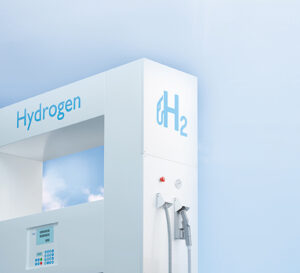The idea of using the world’s most abundant resource (hydrogen) as fuel is not new. According to the World Intellectual Property Organization, Swiss engineer François Isaac de Rivaz patented an engine that used hydrogen and oxygen as fuel in 1806. The idea died quickly when fossil fuel combustion engines proved more feasible.
It was only in 2016 that hydrogen fuel came to the spotlight once more. Countries recognized its potential as a zero-emissions fuel when the EU certified it under the CertiHy Guarantee of Origin that classifies hydrogen’s eco-credentials based on its production methods. It can be “gray,” “blue,” or “green.” Gray (and other shades of black) hydrogen fuel uses oil to produce it. Blue hydrogen is when the production process captures and stores carbon emissions, while green hydrogen utilizes renewable sources like solar or wind.
Countries and international agencies are focusing on green hydrogen as one of the best fuels for significantly reducing emissions to meet the 2030 U.N. target of net zero emissions. “Hydrogen as a fuel offers great potential to decarbonize various industries and hard-to-abate sectors,” said AirSwift, a consultancy specializing in energy and infrastructure, in a February blog. It “replaces fossil fuels in processes such as refining, iron, steel, chemicals and transport.”
Since 2022, the government has been floating the idea of becoming a regional hub for green hydrogen. Its main export target is the EU, which is accelerating its transition from natural gas amid supply disruptions from Russia that started last year. According to Mohamed Shaker, minister of electricity and renewable energy, Egypt had signed 23 green hydrogen MoUs as of December.
To convert those MoUs to FDI, the government should pay attention to what the United States is doing. “Ensuring America is the global leader in the next generation of clean energy technologies requires … government and industry,” said Jennifer Granholm, U.S. Secretary of Energy, in July. “That is why [we are] helping industry unlock the full potential of this incredibly versatile energy resource and supporting [their] long-term success.”

U.S. vision
The U.S. Department of Energy launched its National Clean Hydrogen Strategy and Roadmap in June. Its vision is to commercialize production and maximize the use of green hydrogen: “Achieving commercial-scale clean hydrogen deployment is critical to creating good-paying jobs and new economic opportunities in communities across the nation while also enabling our long-term decarbonization objectives.”
The DOE’s “Pathways to Commercial Liftoff: Clean Hydrogen” report, published in March, said, “A hydrogen economy has the potential to add 100,000 net new direct and indirect jobs by 2030.” That requires incentivizing and supporting multiple sectors to switch to green hydrogen while ensuring enough supply to meet demand.
The report estimates green hydrogen production would have to increase from just under 1 million metric tons in 2022 annually to 10 million metric tons by 2030 to satisfy projected demand. It added that “near-term demand” will likely come from existing use cases transitioning from gray to green hydrogen. By 2050, the DOE forecasts clean hydrogen production should reach 50 million tons annually.
Creating ecosystems
The DOE established the Regional Clean Hydrogen Hubs (H2Hubs) program last year to “help form the foundation of a national clean hydrogen network.” Its funding comes from the Bipartisan Infrastructure Law passed in 2021.
H2Hubs aims to establish six to 10 regional clean hydrogen facilities at an estimated cost of $7 billion. Those centers “will be a central driver in helping communities across the country benefit from clean energy investments, good-paying jobs, and improved energy security.”
The program links hydrogen producers, consumers, and the region’s connection infrastructure to accelerate the decoupling from fossil fuels. “An added benefit of the H2Hubs program is the opportunity to push for a more diverse mix of hydrogen end-use applications,” according to ING Think, the ING Bank’s think tank.
H2Hubs will prioritize investments in “production, processing, delivery, storage, and end-use [applications] of clean hydrogen, including innovative uses in the industrial sector,” noted the U.S. Office of Clean Energy Demonstrations. Those “are crucial for achieving President Biden’s goal of a 100% clean electrical grid by 2035 and net-zero emissions by 2050.
Incentives, incentives
The other “building block” is incentives. Green hydrogen consumers and producers benefit from tax credits under the Inflation Reduction Act (IRA), passed last year. It allocates $369 billion to address energy security and climate change over the next decade.
The IRA gives manufacturers of green hydrogen fuel a tax credit of 2.6 cents on every kilowatt-hour they generate and up to $3 per kilogram of clean hydrogen they produce.
However, those incentives are for valid for the next 10 years. Yuanrong Zhou, a researcher in the International Council on Clean Transportation’s fuels program, said that is about a third of the project’s lifetime. “Projects starting in 2023 would benefit from the full 10 years’ worth of credits, while plants opening later would receive progressively less,” Zhou said.
The IRA also gives green hydrogen producers the option of “tax transferability,” meaning those producers “can sell their tax credits to a buyer who owes taxes.” “The effect of [that option] is still uncertain,” said Zhou, adding that benefiting from this option requires additional “legal and due diligence costs.”
A February note from ING said producers also can get a “one-time investment tax credit of up to 30% of the cost of a qualified clean hydrogen (or hydrogen storage) property.”
She noted this financial support has enticed several U.S.-based manufacturers to scale up their hydrogen dependence and build infrastructure. In the first half of this year, five clean hydrogen projects in the United States were announced, adding to 33 already operational as of the end of 2022.

Challenges
According to the DOE, the first set of challenges facing the U.S. in building a green hydrogen economy is the high cost of infrastructure connecting producers to the project, especially if they are not located in the same vicinity.
ING noted that governments could repurpose existing fossil fuel infrastructure for carrying hydrogen fuel over long distances. Those pipes would “require reconfiguration and adaptation to avoid problems like hydrogen leakage.”
Transporters could blend green hydrogen with natural gas to avoid such upgrades. However, that solution has limitations. “Today, natural gas pipelines can handle up to 20% of hydrogen blending; beyond that … it could damage the pipelines,” said ING.
Meanwhile, using land freight to transport green hydrogen requires “specialized … track and train tanks,” also making their application “limited,” ING said.
Those factors are coupled with the financial unfeasibility of commercializing hydrogen production. According to Statistica Research Department, the estimated cost of producing blue or green hydrogen in the U.S. is between $3 and $4 per kilogram. A barrel of crude oil (136 kilograms) costs from $3 to $12 to refine. AirSwift’s blog post said the higher cost comes from “challenges surrounding production costs, infrastructure, incentivizing demand, storage and transportation.”
To reduce production costs, countries must “invest in extensive innovation and technological breakthroughs,” AirSwift noted. The most effective approach is to lower the cost of electricity used to produce clean hydrogen. Producers also need to “increase the efficiency and operating lifetime of facilities.”
Those solutions should greatly benefit blue and green hydrogen. The former would use new technologies to capture carbon more efficiently and effectively, while the latter would use advanced solutions to lower the cost of renewable energy. AirSwift stressed that promoting those two types of hydrogen fuel would “unlock structural changes from pilot to commercial scale ventures in time to meet net-zero targets.”
The U.S. government says its efforts to entice producers and innovations and increase use cases should bring clean hydrogen costs down to $2 per kilogram by 2025 and $1 by 2030. However, AirSwift stressed those cost estimates are contingent on where the fuel is produced, how it is consumed, and the distribution network and infrastructure used.
Proving credibility
One of the proponents’ most significant concerns is eco-friendly production and transportation. That is a sticking point in the United States, given that incentives have four tiers depending on how much CO2 the hydrogen fuel production produces.
Ensuring the eco-credentials of green hydrogen products requires legislation. Frank Wolak, president and CEO of the Fuel Cell and Hydrogen Energy Association, told Reuters in June, “The Treasury must develop a set of guidelines … The promise of the Inflation Act has been extremely helpful for the United States and has stimulated investments from overseas, but this incomplete guidance leaves unfinished business.” That means developing a system to quantify the “greenness” of each producer.
Wolak stressed such a framework is a “high-stakes game” for the industry because “failure to qualify for the highest tier would undermine the economic viability of any green hydrogen project.”
Another question is how “hydrogen producers demonstrate their use of clean electricity” to benefit from the incentives, noted AirSwift. One way is to purchase that electricity directly from producers without going through the national grid. That would be much easier if a green hydrogen producer also had a renewable power plant.
For those who don’t have that option, AirSwift stressed the importance of having “power purchase agreements” from the grid to ensure supply. The government also should offer and regulate “renewable energy certificates,” which guarantee the purchased electricity is eco-friendly.
The other topic important to hydrogen producers is calculating the “carbon intensity of their delivery,” said AirSwift. For one, it determines how much a producer receives in tax credits from the IRA. “Longer-distance delivery of clean hydrogen could [be] more costly, [requiring] further measures to lower transport carbon intensity.”
The other factor is whether the hydrogen fuel is transported as a gas via pipelines or liquified and transported on trucks that use fossil fuels. AirSwift noted the environmental impact of the latter is “significantly” higher.
Solidifying eco-credentials quickly while creating use cases for green hydrogen, with supply increasing to match demand, is essential to building a hydrogen economy. “The more quickly guidance rules are out,” stressed AirSwift, “the faster projects will be expected to move to their next stages.”







